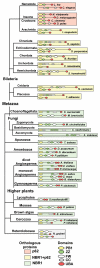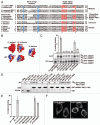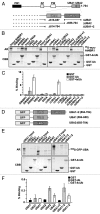Plant NBR1 is a selective autophagy substrate and a functional hybrid of the mammalian autophagic adapters NBR1 and p62/SQSTM1
- PMID: 21606687
- PMCID: PMC3210314
- DOI: 10.4161/auto.7.9.16389
Plant NBR1 is a selective autophagy substrate and a functional hybrid of the mammalian autophagic adapters NBR1 and p62/SQSTM1
Abstract
(Macro)autophagy encompasses both an unselective, bulk degradation of cytoplasmic contents as well as selective autophagy of damaged organelles, intracellular microbes, protein aggregates, cellular structures and specific soluble proteins. Selective autophagy is mediated by autophagic adapters, like p62/SQSTM1 and NBR1. p62 and NBR1 are themselves selective autophagy substrates, but they also act as cargo receptors for degradation of other substrates. Surprisingly, we found that homologs of NBR1 are distributed throughout the eukaryotic kingdom, while p62 is confined to the metazoans. As a representative of all organisms having only an NBR1 homolog we studied Arabidopsis thaliana NBR1 (AtNBR1) in more detail. AtNBR1 is more similar to mammalian NBR1 than to p62 in domain architecture and amino acid sequence. However, similar to p62, AtNBR1 homo-polymerizes via the PB1 domain. Hence, AtNBR1 has hybrid properties of mammalian NBR1 and p62. AtNBR1 has 2 UBA domains, but only the C-terminal UBA domain bound ubiquitin. AtNBR1 bound AtATG8 through a conserved LIR (LC3-interacting region) motif and required co-expression of AtATG8 or human GABARAPL2 to be recognized as an autophagic substrate in HeLa cells. To monitor the autophagic sequestration of AtNBR1 in Arabidopsis we made transgenic plants expressing AtNBR1 fused to a pH-sensitive fluorescent tag, a tandem fusion of the red, acid-insensitive mCherry and the acid-sensitive yellow fluorescent proteins. This strategy allowed us to show that AtNBR1 is an autophagy substrate degraded in the vacuole dependent on the polymerization property of the PB1 domain and of expression of AtATG7. A functional LIR was required for vacuolar import.
Figures







Similar articles
-
Dual roles of AtNBR1 in regulating selective autophagy via liquid-liquid phase separation and recognition of non-ubiquitinated substrates in Arabidopsis.Autophagy. 2024 Dec;20(12):2804-2815. doi: 10.1080/15548627.2024.2391725. Epub 2024 Aug 28. Autophagy. 2024. PMID: 39162855 Free PMC article.
-
NBR1 and p62 as cargo receptors for selective autophagy of ubiquitinated targets.Cell Cycle. 2009 Jul 1;8(13):1986-90. doi: 10.4161/cc.8.13.8892. Epub 2009 Jul 30. Cell Cycle. 2009. PMID: 19502794
-
AtNBR1 Is a Selective Autophagic Receptor for AtExo70E2 in Arabidopsis.Plant Physiol. 2020 Oct;184(2):777-791. doi: 10.1104/pp.20.00470. Epub 2020 Aug 5. Plant Physiol. 2020. PMID: 32759269 Free PMC article.
-
Selective autophagy mediated by autophagic adapter proteins.Autophagy. 2011 Mar;7(3):279-96. doi: 10.4161/auto.7.3.14487. Autophagy. 2011. PMID: 21189453 Free PMC article. Review.
-
NBR1: The archetypal selective autophagy receptor.J Cell Biol. 2022 Nov 7;221(11):e202208092. doi: 10.1083/jcb.202208092. Epub 2022 Oct 18. J Cell Biol. 2022. PMID: 36255390 Free PMC article. Review.
Cited by
-
Suppression of Metacaspase- and Autophagy-Dependent Cell Death Improves Stress-Induced Microspore Embryogenesis in Brassica napus.Plant Cell Physiol. 2021 Feb 4;61(12):2097-2110. doi: 10.1093/pcp/pcaa128. Plant Cell Physiol. 2021. PMID: 33057654 Free PMC article.
-
hfAIM: A reliable bioinformatics approach for in silico genome-wide identification of autophagy-associated Atg8-interacting motifs in various organisms.Autophagy. 2016 May 3;12(5):876-87. doi: 10.1080/15548627.2016.1147668. Epub 2016 Apr 12. Autophagy. 2016. PMID: 27071037 Free PMC article.
-
Combined Proteomic and Metabolomic Profiling of the Arabidopsis thaliana vps29 Mutant Reveals Pleiotropic Functions of the Retromer in Seed Development.Int J Mol Sci. 2019 Jan 16;20(2):362. doi: 10.3390/ijms20020362. Int J Mol Sci. 2019. PMID: 30654520 Free PMC article.
-
Potential Biotechnological Applications of Autophagy for Agriculture.Front Plant Sci. 2021 Oct 27;12:760407. doi: 10.3389/fpls.2021.760407. eCollection 2021. Front Plant Sci. 2021. PMID: 34777441 Free PMC article. Review.
-
AUTOPHAGY-RELATED11 plays a critical role in general autophagy- and senescence-induced mitophagy in Arabidopsis.Plant Cell. 2014 Feb;26(2):788-807. doi: 10.1105/tpc.113.120014. Epub 2014 Feb 21. Plant Cell. 2014. PMID: 24563201 Free PMC article.
References
Publication types
MeSH terms
Substances
LinkOut - more resources
Full Text Sources
Other Literature Sources
Molecular Biology Databases
Research Materials
Miscellaneous
